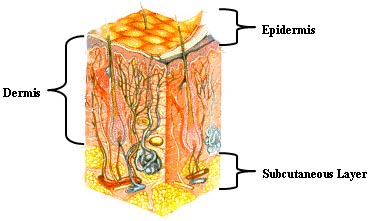| FDA
> CDRH > Tanning > Your Skin
Your Skin
Basic Skin Anatomy
Believe it or not, skin is actually your body’s largest organ! All skin is made up of three primary layers:
- Epidermis (top layer)
- Dermis (middle layer)
- Subcutaneous layer or hypodermis (lower layer)

Skin has several very important tasks, including:
- Protecting the muscles, bones, and organs of your body
- Regulating body temperature
- Encasing the nerves that enable your sense of touch and relay messages—like the tactile sensations of soft, hard, hot, cold, comfort, and pain—to your brain.
More Information on How Skin Works

How do I know what my skin type is?
Accurate determination of skin type requires experience. However, you may estimate your skin type using the following table:
| SKIN TYPE |
SKIN COLOR |
SKIN COLOR |
| I |
Pale white |
Always burns - never tans |
| II |
White to light beige |
Burns easily - tans minimally |
| III |
Beige |
Burns moderately – tans gradually to light brown |
| IV |
Light brown |
Burns minimally - tans well to moderately brown |
| V |
Moderate brown |
Rarely burns - tans profusely to dark brown |
| VI |
Dark brown or black |
Never burns – tans profusely |
The Health Protection Agency, a branch of the government of the United Kingdom, offers an interactive module on skin types (requires Flash player; download now).

Are dangers of UV exposure the same for everyone?
Factors such as age, health, and skin type all determine how an individual will be affected by UV exposure.
People over the age of 50 and under the age of 5 are generally more sensitive to the harmful effects of UV. Those with immune deficiencies and chronic diseases also tend to be more susceptible to the side-effects of UV exposure.
In general, people with medium to dark complexions are less sensitive to UV exposure. Although people with darker complexions are less likely to get skin cancer than people with lighter complexions, they can still develop malignancies and suffer all forms of UV damage.
Dermatologists divide human skin into six types. Type I is the most sensitive and type VI is the least sensitive. People with skin type I are at a particularly high risk and should try to avoid exposure to UV.
People who need to be especially careful in the sun are those who have:
- Pale skin
- Blonde, red, or light brown hair
- Been treated for skin cancer
- A family member who’s had skin cancer
Certain oral and topical medicines, such as antibiotics, birth control pills, and benzoyl peroxide products, as well as some cosmetics, may increase skin and eye sensitivity to UV in all skin types. Check the label and ask your doctor for more information.

Updated August 3, 2007 |



![]()